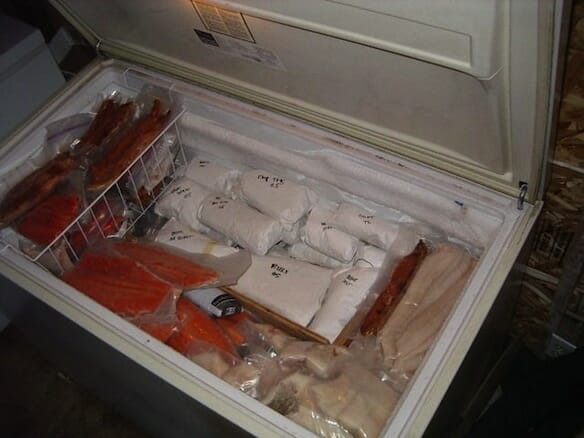
Image credit: ABCH.
The Cold-Down on Freezers
You may find yourself with a family growing larger, and more food consumed each week than you can believe. You may be budget conscious, and hip to the advantages of buying food in bulk. Or maybe you’re a successful outdoors person, who often comes home with fresh fish or game that can’t be consumed all at once. In all these cases, what you want to do is freeze foodstuffs for later. While it’s true that most every kitchen refrigerator comes with a freezer unit, often these freezers are too small for your purposes. When a trip to your local big box retailers for food ends up with your kitchen freezer brimful, it’s time to consider adding a dedicated freezer to your household. These simple stand-alone freezer units are big, cold, and last for years One might be just the thing for you.
How Much Capacity?
Your first decision will have to do with capacity. We’ll talk about the difference between upright freezers and chest freezers in a moment, but no matter which you choose, you’ll have to figure out how much usable space you’ll require. A freezer too small defeats the purpose, while a freezer too large means you’re wasting money on electricity. A good rule of thumb is that a cubic foot of a freezer can hold about 30 pounds of food, including its packaging. A family of four could get by with a 10 cubic foot freezer. A bigger family, or one that brings home a lot of produce or meat at the same time to keep for many months, will want a larger freezer. A 14.8 cubic foot model might be perfect. If you already have a freezer, you may be better off adding another smaller one than trying to consolidate into one larger model.
Upright or Chest?
There are two configurations for dedicated, stand-alone freezers. Upright freezers are built like your normal refrigerator. An upright freezer will stand on feet, and be much higher than it is wide. It has a door that opens conventionally. Its main advantage is accessibility. It’s easier to open a regular freezer door than to open a freezer like a chest. Also, once the door is open, all your food will be displayed on shelves for you to see. You won’t have to dig deep into the freezer to unearth the frozen lasagna for which you’re searching. If you have frozen food that tends to get used quickly, then an upright freezer is your best bet. They often have moveable shelves.
Chest freezers, on the other hand, are lower to the ground. They open from the top. What’s great about a chest freezer is that all its space inside is usable. You won’t be obstructed by shelves or doors – you can store a side of beef that would never fit into an upright freezer. The disadvantage is that you may have to moves items to reach other items. Another plus for the chest freezer is that it takes advantage of physics. Cold air sinks, so when you open the lid, only the warmest air in the freezer will escape. Temperatures are well controlled and well maintained.
Defrosting
Freezers accumulate frost. Modern freezers are quite airtight and efficient, so defrosting should not be more than an occasional issue. Even so, you’ll want to think about whether you want a frost-free upright, or a freezer that requires manual defrosting. Manual defrost involves emptying the freezer and pulling a drain plug. Remember that with a frost-free upright, air will circulate inside. Circulating cold air can cause freezer burn after several months, so be cautious with very long term storage in a frost-free upright machine.
Extra Points
Both upright and chest freezers are now energy efficient. Look for the same kind of EnergyStar designation you would find on a refrigerator to guide you in how much electricity any given unit can be expected to use. Also, pay attention to whether your unit has an interior light or not. Many freezers are stored either in the basement or the garage, and it would be annoying to have to bring a flashlight to look inside your freezer.



